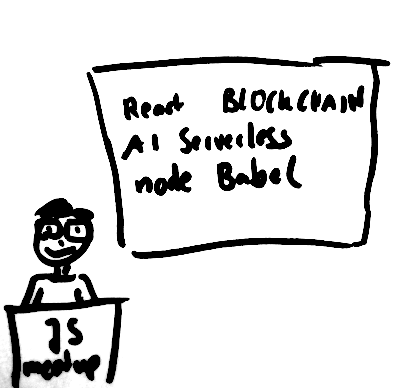Latest news about Bitcoin and all cryptocurrencies. Your daily crypto news habit.
 HOBBY ANTHROPOLOGY IN THE AGILE AGEA humoristic taxonomy
HOBBY ANTHROPOLOGY IN THE AGILE AGEA humoristic taxonomy
If you have spent some time in big companies that do “Agile”, you might have noticed that there are quite a few recurrent patterns. People slip into stereotypical roles, as has been true for every organizational fad since the Roman legions have been transformed by Gaius Marius. Let’s try to survey them for “Agile” enterprise organizations!
Corporate anthropology has become a serious research topic in the last 20 years or so, with good reason. Please note that this article is neither serious, nor scientific. Please note also, that slipping into the stereotypes to me appears to be completely uncorrelated to gender, so I am just alternating the personal pronouns here.
The Agile Court Jester
The Agile court jester fits into a very important ecological niche that often arises when the CEO has let it be known, that henceforth the company should adopt more of this “Agile” thing. Every director or VP with at least a decent level of cunning knows that it is important to appear “Agile” now. The smarter ones know that faking it only brings you so far. What you need to do is to retain at your court a true believer, someone who preaches “Agile” to everyone within hearing range, generating a lot of activity and buzz that is coincidentally picked up by the CEO. Just make sure this person does not become dangerous by really trying to change things. This is where the Agile court jester comes in handy. He likes to be at the forefront of the revolution (without getting bloody). He also likes the fact, that besides buzz and activity, no tangible results are expected from him.
Typical quote: “I am too early.”
What can you do? Actually, if the Agile court jester is at least a decent public speaker, he can do a lot to disseminate Agile ideas among the company’s staff. Just make sure he does not spread too much fake Agile.
The Ignorant Line Manager
Agile is neither part of the company’s process handbook, nor part of her bonus agreement. So why take it serious? She is sending out 1:1 appointments that conflict with Sprint rituals. She assigns Scrum team members to “special tasks” without caring about the Sprint. She actively encourages specialization. Her direct reports should sit close to her corner office, who cares about co-location?
Typical quote: “What is a Sprint? Since when are you guys doing sports?”
What can you do? Conspire to update her personal bonus targets to this:
- Establish a continuous delivery pipeline for your team(s) until the end of the year.
- Features must be released on their own, with at least two releases per business day on average.
MWAHAHAHAHA
The Angry Line Manager
The angry line manager is really annoyed by this whole “Agile bullshit”. No one is taking responsiblity anymore. The teams are stuck in infinite loops of Retro discussions. Scrum Masters are agitating against middle management. Anarchy is breaking loose. And his boss is buying the Agile snake oil while still making him responsible for the whole mess.
Typical quote: “Stop bullshitting me!”
What can you do? He just wants to be taken seriously and play with the other kids. Maybe invite him to a round of delegation poker?
The Populist Scrum Master
Being the Scrum Master in a corporate environment can be a very taxing challenge. On the one hand, lots of organizational impediments (e.g. just four releases per year) have to be overcome. On the other hand, the team members’ mind set has been formed by years of exposure to a corporate hierarchy. But wait. Who said you really have to overcome anything, or change your team’s mind set? This is a corporate environment, you are not measured by results, but by social acceptance! And you can bet that the populist Scrum Master is accepted by her team, thanks to good old populism. The team is unsure how to explain a recent failure? She will find someone to blame. Home office conflicts with Sprint rituals? She will make sure you can opt out of the rituals, instead of making the rituals work for remote participants. Customer support complains about too many bugs? She will shoot the messenger. The Product Owner makes the team feel uncomfortable? She makes sure it’s mutual. She will protect the team from the ambition of others, and also from their own ambition.
Typical quote: “Should we really release today? How about waiting until Monday?”
What can you do? As always with populism, you have to wait until the collapse. And make sure the populist Scrum Master cannot blame you for that as well. Or just lay back and enjoy the illusion while it lasts.
The Clueless Product Owner
He is the personification of the peter principle, having started at the company as a customer support person, a UX guy, or a developer, and then being the only one around willing to work as a Product Owner for the low salary the company is willing to pay. Or, as usually happens, he was simply not able to say no to his boss. Now he has to guide a full-blown cross-functional team poised for action and creativity, has to tame his share of vicious corporate stakeholders, and even needs to develop an understanding of what the customers want. Unfortunately, he is not aware of these challenges, and absolutely incapable of meeting them. He has no drive and no ideas on what to do with the product. He cannot clarify anything, and so is not able to put something meaningful into the backlog. Whenever a stakeholder pushes for something, he forwards it directly to the team. The team thinks he is weak and cannot stick to a plan (what plan?), so they don’t take him seriously. By the time he realizes that there is a political game of rugby going on, with him being the ball, it is too late.
Typical quote: “I cannot decide that now.”
What can you do? Not much. He is a hopeless case. Maybe push for introducing LeSS, so he is not needed anymore, and can happily revert to his old role without responsibility.
The Passive-Aggressive Senior Developer
She told anyone who would ask that this would not work. Of course management, as always, overlooked her when making their decision, and did not ask her. She would not tell them, because making proper decisions is their job. And the company could have promoted competent people into management. Such as her. Of course, she did not apply for the team lead position when it was opened. If the boss would have done his job properly, he would have asked her. Because after all that she has done for the company, she would have been the natural choice.
Being denied her fair chance, the least she can do is to make sure her team treats her with the appropriate level of respect due. The absence of supervision in a self-organizing team gives her oh so many chances to do so. If a new developer joins, she will make sure to be the reviewer of his first big pull request. And boy, will she make that guy suffer. It is important that he learns right from the start, who is in charge here. The Scrum Master has ideas? She will make sure the team opposes them. The status quo always works best for her, especially because you know whom to blame when something goes wrong. The Product Owner has ambitions? She will thwart them out of principle.
Typical quote: “A good idea. Unfortunately it will not work because…”
What can you do? Try to understand her grudge, and maybe address it. But more important is to make the team realize that there is a wolf in sheep’s clothes among them.
The Hipster Developer
He likes to go to meetups, and talk about the new stuff he has tried out recently at work. It pains him to hear about a fancy new JavaScript framework, while not being able to actually ship some code that uses it. Whenever some backward-thinking boss talks about not walking into a cloud vendor lock-in trap, he takes it as a personal insult. Every programming language that has been around at the company since more than two years is by definition not cool. Fortunately, in a Scrum team, the majority opinion can be shifted towards a more progressive stance on framework adoption. In the end, everyone wants a modern-looking CV. Which turns out to be useful when the team is finally disbanded due to absolutely failing to meet any business requirements, let alone the customer’s needs (while being lightyears ahead of the company’s technology roadmap).
Typical quote: “Our frontend framework is completely outdated.”
What can you do? Make sure to praise him when he delivers a user story without changing the architecture. Make sure the whole team gets to decide on every new dependency. And then never forget to ask about the learning effort — that should reign him in.
The Scrum Secretary
You know the team has a Scrum Secretary instead of a Scrum Master by just looking at the Sprint board. Her handwriting is on all tickets. Which she has transcribed meticuously from JIRA. During backlog refinement, she stenotypes every utterance directly into JIRA. She will compile any weekly KPI report requested by anyone, even though no one reads it. As you might have guessed by now, she has been working in a PMO role before. While everybody complains that the company is perverting Agile by handing it down with a process handbook, she is actually quite happy about it.
Typical quote: “Let’s fill this out!”
What can you do? The Scrum Secretary has her strengths. The team will always have a conference room reserved for their meetings. But still you need to wean the team off her tight processual embrace, so they can start thinking by themselves about how they want to work as a team.
The Superfluous Scrum Master
He is there. Besides emitting carbon dioxide to the office plant’s delight, he is not contributing much to the team’s productivity. OK, that’s not fair. He is sending out the Outlook invitations. The reason for his reluctance to act is that he does not want impede the team’s self-organization. And maybe he is a bit afraid of being exposed as a Scrum novice. But without acting, you cannot learn a craft, so he is not making any progress.
Typical quote: “What would you decide?”
What can you do? Explain to him the concept of Shuhari applied to Scrum. And strengthen his back so he dares to act.
The Ambitious Scrum Master
She is a former consultant, and she already helped a lot of teams on their way to top performance. When the consultancy kicked her out and not up, she jumped onto the Agile train. Now she is there to help YOU! As the teams are not as smart as her, they need to listen to her ideas. There are just two things about Scrum she does not like: First, self-organization does not work without smart people like her. Second, in this whole team thing, it is really hard not to receive credit, where credit is due. Unfortunately, the consultancy has poisoned her mind so much that she cannot even spell the word “sustainable” anymore.
Typical quote: “I would recommend…”
What can you do? Modern clinical psychotherapy has ways to induce empathy into former criminals or business consultants.
The Project Managing Scrum Master
He is a victim of the Agile wave. Before it washed over the company, he had eked out a comfortable position as a project manager. Then management switched the company from ITIL to SAFe over night, and everybody tried to find a new stone to hide under. His boss set him up as a new Scrum Master. If there is one thing he learned from his long time at the company, it is loyality. So without questioning his boss’s decision he started to call himself Scrum Master, even though in his ears it does not sound as prestigious as his previous position. Other than that, not much has changed. Most important, his company car is staying the same. Maybe there is a bit of tension within his Scrum team, as everything critical that is spoken within the team somehow reaches the ears of the boss. Maybe Scrum is not really implemented by the book. Maybe the team is neither a team, nor self-organizing. But who would want to be so dogmatic? ITIL was also taken more as a rough guidance (otherwise the company would not exist anymore today).
Typical quote: “I am here to help.”
What can you do? Run! He is just the symptom of a much bigger malaise.
A grain of truth
I hope you had at least a few good laughs while reading this article. Maybe you were recognizing a colleague. Maybe even yourself. Now step back, and ask yourself how someone ends up filling out a stereotype. Maybe a few are psychopaths who have found their true calling. But the majority are there because their company culture has led them. Some stereotypes can be explained by Larman’s tragicomic laws. But everybody deserves at least some career counseling and a training before switching into a new role. And most people new to the Agile software development environment need a bit of personal coaching in the beginning. So if you have the chance, give these stereotypical people a chance!
Agile Enterprise Stereotypes was originally published in Hacker Noon on Medium, where people are continuing the conversation by highlighting and responding to this story.
Disclaimer
The views and opinions expressed in this article are solely those of the authors and do not reflect the views of Bitcoin Insider. Every investment and trading move involves risk - this is especially true for cryptocurrencies given their volatility. We strongly advise our readers to conduct their own research when making a decision.










